Introduction
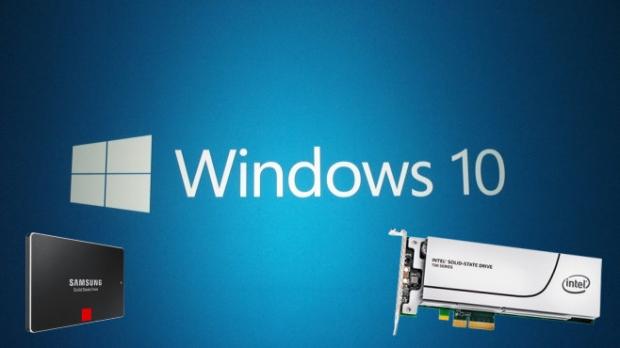
From the day Microsoft Windows 10 launched, I have been inundated with the same question:
"How is storage performance on Windows 10?"
We are sure a lot of our readers want a definitive answer, so that's what we are going to examine today. We are upgrading our consumer storage test rigs to Windows 10, so going forward all TweakTown consumer SSD reviews will be performed utilizing Microsoft's latest and greatest operating system.
To fully answer the question, we will also need to examine the performance of different drivers and the impact they have on Windows 10 storage performance. We will look at SATA performance utilizing two drivers, RST 13.6 and RST 14.5. With Windows 8.1 our favorite single SSD driver is RST 13.2, but that driver is not compatible with Windows 10. Intel's RST 13.2 driver requires .Net 4.5 and you cannot install .Net 4.5 on Windows 10. We tried our best to install .Net 4.5, but Windows 10 comes with .Net 4.6 pre-installed, which prevents .Net 4.5 from being installed.
We will also look at PCIe NVMe performance and compare the performance of Windows 8.1 to that of Windows 10 utilizing an Intel 750 400GB AIC SSD. Intel provides a proprietary driver for the 750 series and we will be utilizing that driver for both Windows 8.1 and 10. Most of our focus will be on SATA performance and we will briefly examine Windows 10 PCIe NVMe storage performance.
We saw a significant storage performance downgrade when we moved from Windows 7 to Windows 8.1. Will the same trend continue, or will Windows 10 provide equal or better storage performance than Windows 8.1? Let's find out.
Test System Setup and Properties
Test System Configuration
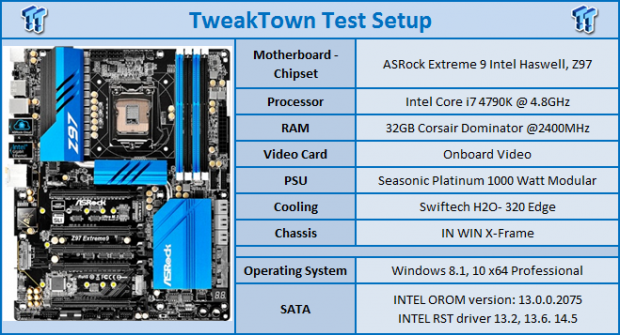
We would like to thank the following companies: ASRock, Crucial, Intel, Corsair, RamCity, IN WIN, and Seasonic for making our test system possible.
Drive Properties
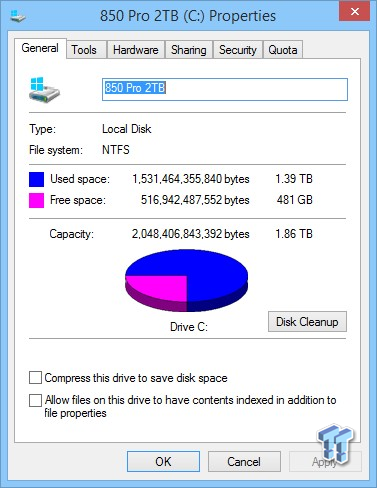
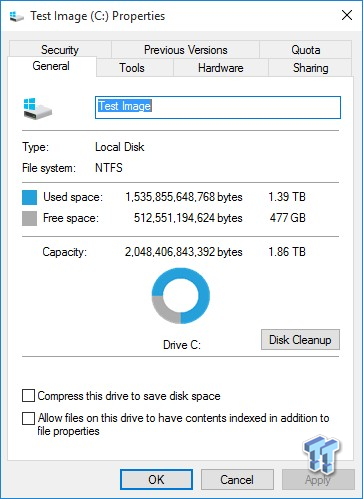
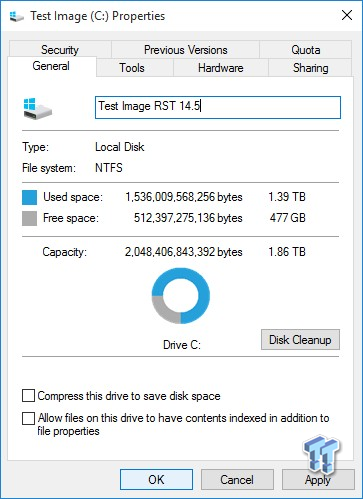
The majority of our testing is performed with our test drive as our boot volume. Our boot volume is 75% full for all OS Disk "C" drive testing to replicate a typical consumer OS volume implementation. We feel that most of you will be utilizing your SSD's for your boot volume and that presenting you with results from an OS volume is more relevant than presenting you with empty secondary volume results.
System settings: Cstates and Speed stepping are both disabled in our systems BIOS. Windows High Performance power plan is enabled. Windows write caching is enabled, and Windows buffer flushing is disabled.
It is interesting to note that with RST 14.5, the Intel driver no longer handles write caching; it's handled by Windows.
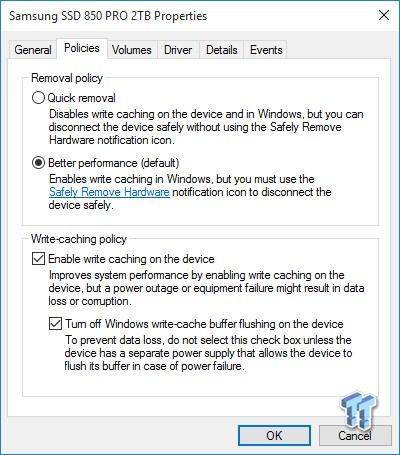
We will first test utilizing a 2TB Samsung 850 Pro as our OS volume 75% full. We will present results for Windows 8.1 using RST 13.2. For Windows 10, we will present results using RST 13.6 and RST 14.5. Results will be presented in the following order: Win 8.1 RST 13.2, Win 10 RST 13.6 and Win 10 RST 14.5.
Next, we will compare driver performance on Windows 10 with a 500GB Samsung EVO empty running both RST 13.6 and 14.5. Lastly, we will look at the difference in performance between Windows 8.1 and 10 using a 400GB Intel 750 Series NVMe PCIe SSD.
Synthetic Benchmarks - ATTO & Anvil Storage Utilities
ATTO
Version and / or Patch Used: 2.47
ATTO is a timeless benchmark used to provide manufacturers with data used for marketing storage products.



Windows 8.1 and 10 are performing about the same. The difference is so insignificant it can be chalked up to normal variability between runs.
Anvil Storage Utilities
Version and / or Patch Used: 1.1.0
Anvil's Storage Utilities is a storage benchmark designed to measure the storage performance of SSD's. The Standard Storage Benchmark performs a series of tests; you can run a full test or just the read or write test, or you can run a single test, i.e. 4k QD16.
Anvil's scoring gives a good indication of a drives overall performance.

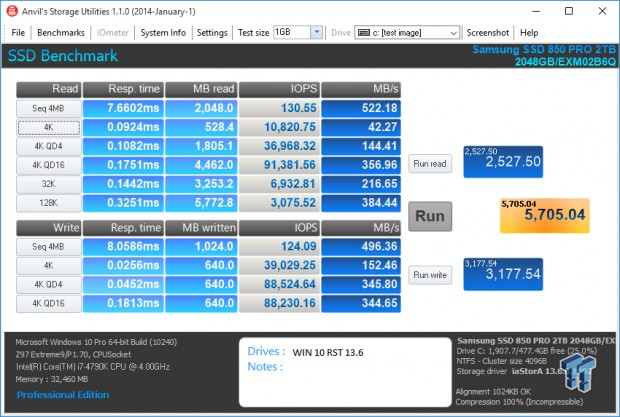
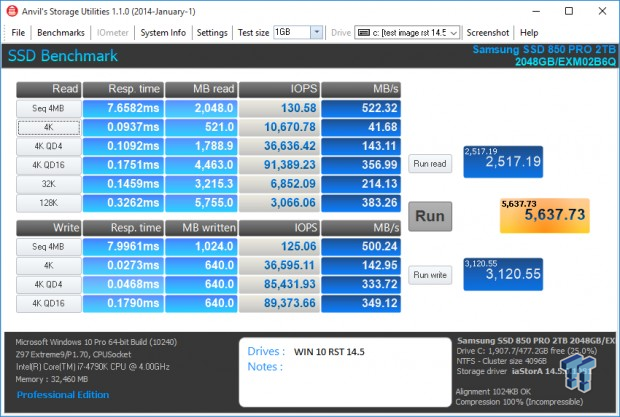
Anvils is showing a slight difference between Windows 8.1 and 10 with RST 13.6. This difference is close enough that it can be considered variability between runs. Windows 10 with RST 14.5 is clearly being outperformed, mostly with 4K QD1 write.
Synthetic Benchmarks - CrystalDiskMark & AS SSD
CrystalDiskMark
Version and / or Patch Used: 3.0 Technical Preview
CrystalDiskMark is disk benchmark software that allows us to benchmark 4k and 4k queue depths with accuracy. Note: Crystal Disk Mark 3.0 Technical Preview was used for these tests since it offers the ability to measure native command queuing at QD4.
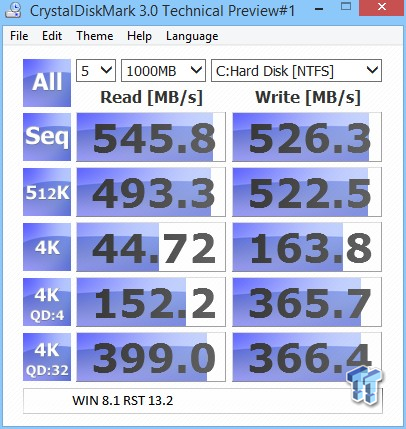


Just as we saw from Anvils, Windows 8.1 and Windows 10 with RST 13.6 perform similarly. Windows 10 with RST 14.5 has lower 4K QD1 performance.
AS SSD
Version and / or Patch Used: 1.7.4739.38088
AS SSD determines the performance of Solid-State Drives (SSD). The tool contains four synthetic as well as three practice tests. The synthetic tests are to determine the sequential and random read and write performance of the SSD.

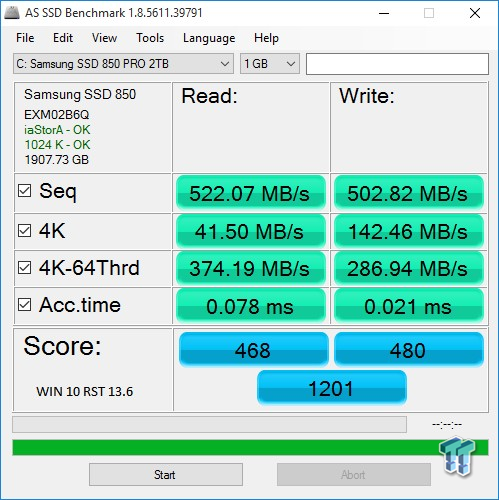

More of the same. We are starting to see a trend developing. 13 series drivers deliver superior 4K performance. Will that translate into higher performance with moderate workloads? Let's see.
Benchmarks (Trace Based OS Volume) - PCMark Vantage, PCMark 7 & PCMark 8
Moderate Workload Model
We categorize these tests as indicative of a moderate workload environment.
PCMark Vantage - Hard Disk Tests
Version and / or Patch Used: 1.2.0.0
The reason we like PCMark Vantage is because the recorded traces are played back without system stops. What we see is the raw performance of the drive. This allows us to see a marked difference between scoring that other trace-based benchmarks do not exhibit.
OS Volume 75% Full - Lightly Used



These results are what we would expect to see based on the 4K random performance we saw from our synthetic testing. Windows 8.1 takes the win here, followed once again by Win 10 with RST 13.6 and the Win 10 with RST 14.5.
PCMark 7 - System Storage
Version and / or Patch Used: 1.4.0
We will look to Raw System Storage scoring for an evaluation because it's done without system stops and therefore allows us to see significant scoring differences between drives.
OS Volume 75% Full - Lightly Used
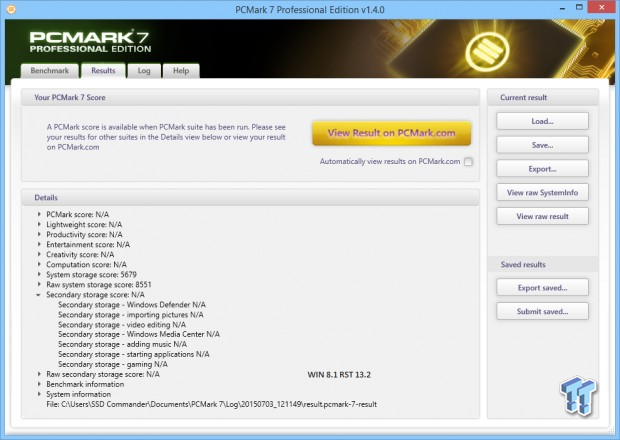


Win 8.1 wins again, but this time Windows 10 with RST 14.5 edges out Win 10 with RST 13.6 for the second best performance.
PCMark 8 - Storage Bandwidth
Version and / or Patch Used: 2.4.304
We use PCMark 8 Storage benchmark to test the performance of SSDs, HDDs, and hybrid drives with traces recorded from Adobe Creative Suite, Microsoft Office, and a selection of popular games. You can test the system drive or any other recognized storage device, including local external drives. Unlike synthetic storage tests, the PCMark 8 Storage benchmark highlights real-world performance differences between storage devices.
OS Volume 75% Full - Lightly Used



PCMark 8 is the most intensive moderate workload simulation we run. With respect to moderate workloads, this test is what we consider the best indicator of a drive's moderate workload performance. We weren't expecting this; Windows 10 with RST 14.5 significantly outperforms our other two configurations. Now let's see if there is a difference between Win 10 running RST 13.6 and 14.5 on a more mainstream capacity SSD, the highly popular Samsung 850 EVO 500GB.
Benchmarks (Secondary Volume)
850 EVO 500GB


There is very little difference between the two drivers; a slight edge goes to RST 13.6. The performance of Windows 10 is looking really good in this test.


Anvil's shows a little more separation between the two drivers with RST 13.6 delivering superior performance.
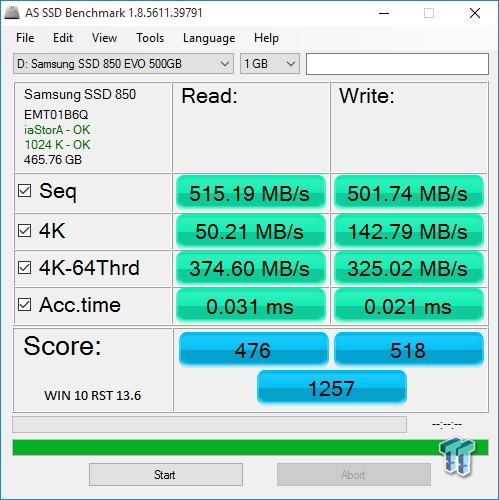

Here we see identical performance with this test.


RST 13.6 again delivers superior performance to that of 14.5.

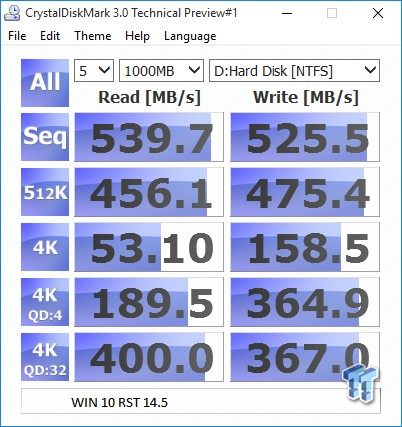
With our final test, 13.6 edges out 14.5 again, mostly due to superior 4K QD1 write performance.
VERDICT: Okay, that's a wrap for our examination of Windows 10 SATA performance. We feel comfortable in concluding that Windows 10 will deliver SATA performance that is equivalent to Windows 8.1. We also feel that overall RST 13.6 outperforms RST 14.5 when running on Windows 10. We saw a significant dip in overall SATA performance coming from Windows 7 to Windows 8, 8.1 and we are happy that trend did not continue with Windows 10.
SATA is quickly becoming obsolete in the enthusiast sector, with PCIe NVMe SSD's becoming more prevalent, so let's quickly compare Windows 8.1 to Windows 10 with a PCIe NVMe SSD on the next page.
Benchmarks (Secondary Volume) PCIe NVMe
Intel 750 Series 400GB


There is very little difference between the two OS's in this test. We will call this a tie.


Windows 10 destroys Windows 8.1 in this test. We tested several times to confirm this.

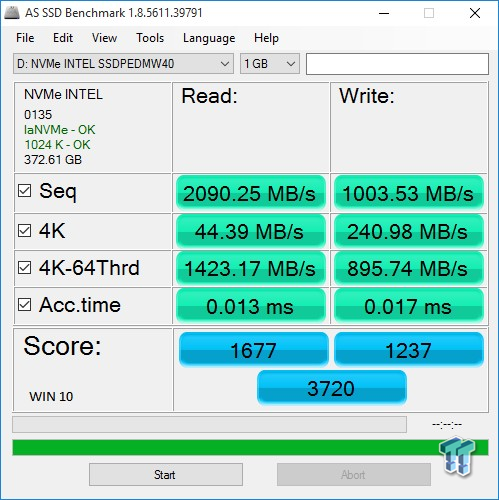
Again Windows 10 crushes Windows 8.1. Look at the difference in write latency. Write latency is much lower on Windows 10 than 8.1 and that really shows when you compare 4K QD1 write performance.


Windows 8.1 edges out Windows 10 in this test by the slightest of margins.
VERDICT: Overall, we feel comfortable saying that Microsoft's newest OS will deliver better performance with PCIe NVMe SSD's than Windows 8.1.
Final Thoughts

Microsoft's newest OS is polished and we are really enjoying it so far. Most of all, we are happy to report that Windows 10 storage performance is very good. As far as SATA is concerned, we are comfortable in saying Windows 10 delivers performance that is equivalent to Windows 8.1. TweakTown will be utilizing Windows 10 for consumer storage testing moving forward. Overall, we prefer RST 13.6 to RST 14.5 and that is the driver we will be using at least for now, till a better one comes along.
Looking at PCIe NVMe, it is pretty clear that Windows 10 delivers superior performance in comparison to Windows 8.1. This is something that we are really glad to see, because we are moving into a new era of storage performance and SATA is not coming along with us. Today's SATA SSD's are becoming yesterday's HDD's in terms of enthusiast grade performance.
We hope that this performance analysis overview gave you some insight into what you can expect from Windows 10 with regard to SSD storage performance.


 United
States: Find other tech and computer products like this
over at
United
States: Find other tech and computer products like this
over at  United
Kingdom: Find other tech and computer products like this
over at
United
Kingdom: Find other tech and computer products like this
over at  Australia:
Find other tech and computer products like this over at
Australia:
Find other tech and computer products like this over at  Canada:
Find other tech and computer products like this over at
Canada:
Find other tech and computer products like this over at  Deutschland:
Finde andere Technik- und Computerprodukte wie dieses auf
Deutschland:
Finde andere Technik- und Computerprodukte wie dieses auf